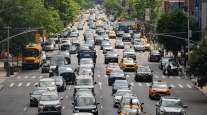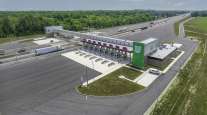NYC Congestion Pricing Encouraged by Transportation Group

[Stay on top of transportation news: Get TTNews in your inbox.]
New York’s congestion pricing plan should include fees on motorists both entering and leaving midtown Manhattan, as well as variable rates linked to peak and off-peak hours to encourage commuters to choose the least busy times to travel, a transportation group recommended.
The plan could generate about $1 billion annually under a variety of scenarios, the Regional Plan Association said in a study called “Congestion Pricing in NYC: Getting it Right.”
The RPA, a nonprofit research group, has influenced policies in New York, New Jersey and Connecticut for more than a century, including the decision more than 90 years ago to build the George Washington Bridge. Its recommendations represent the first public cost-benefit analysis of potential fee schedules since the state legislature enacted the congestion pricing law earlier this year.
That law will require fees paid by individual motorists below Manhattan’s 60th Street, with the goals of reducing traffic and carbon emissions in Manhattan’s central business core and producing enough revenue to finance mass-transit improvements.
WANT MORE NEWS? Listen to today's Daily Briefing
Unnamed Board
Decisions on pricing and other policies will be made by Dec. 31, 2020, by a six-member Traffic Mobility Review Board that has yet to be appointed.
“It will allow us to unclog our streets, improve quality of life and health, help meet state clean air goals, and raise much-needed revenue for our public transportation system,” the RPA report concludes. “The next 15 months will prove to be a critical time as proposals arise and begin to shape what the program looks like.”

(John Taggart/Bloomberg News)
Though the report doesn’t recommend a specific pricing scheme for drivers entering and leaving midtown Manhattan’s heavily trafficked business core, it calculates how much revenue the state’s Metropolitan Transportation Authority would reap, depending upon whether it chooses to institute one consistent price or a set of fees based upon day of the week and time.
Rush Hour
The RPA presented four scenarios, each producing about a $1 billion a year, enough to pay debt service on $15 billion in bonds for mass transit improvements: A $9.18 rush-hour charge, balanced with a $3.06 off-peak fee, would produce a 16% traffic speed increase. An all-day $6.12 flat-fee, with a half-price 11 p.m. to 5 a.m. price, would result in a 10% speed-up, according to the RPA analysis. The calculations assume trucks would be charged as much as 2.5 times what private motorists pay.
Each scenario takes into account that vehicles traveling into the zone after paying tolls on the Robert F. Kennedy, George Washington, and Henry Hudson Bridges in upper Manhattan would be credited for the tolls they paid, the RPA said.
“The region’s existing tolling structure is a mishmash of policies that have developed over time under the jurisdiction of different entities,” the report notes. “Some people drive into Manhattan’s central business district for free, some pay a toll in both directions, and some pay only one way.”
Such toll disparities create “perverse incentives” for drivers to engage in “toll-shopping,” clogging highways and driving miles out of their way to save money, the RPA said. The group warned policymakers to be mindful of this problem in setting up its fee structure.
Each Way
A charge each way, both entering and leaving Manhattan, would encourage drivers to shift trips out of the peak period when possible and permit prices to be used most effectively to reduce congestion as morning and evening peak traffic patterns differ, the RPA said.
According to the congestion pricing law, passenger cars may be charged only once daily for entering or remaining in the zone, with 80% of revenue dedicated to city subways and buses and 10% to rail lines serving commuters on Long Island and communities north of Manhattan.
Those exempt from paying fees include ambulances and vehicles serving disabled persons. Manhattan residents earning less than $60,000 per year will get a tax credit equal to what they have paid. The RPA recommended limiting exemptions, noting that they will make the fees more expensive for non-exempt motorists.
“Any discounts or exemptions granted to particular classes of users will erode the revenue and congestion mitigation impacts of the program, and increase the burden on non-exempt users,” the RPA report states. “The exemptions specified in the legislation are already estimated to reduce overall revenues by about 4% per year.”
What hasn’t been determined yet include decisions on the technology to be deployed to charge vehicles entering the zone, the price and any variation based upon time or day of the week. The Traffic Mobility Review Board must also determine whether to allow additional exemption credits, or discounts, and create ways to measure the effectiveness of the program. The MTA will determine which projects will be funded.




